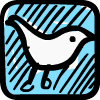Just as you can take a stand and ask your racist relative to get out of your house, if Thanksgiving dinner gets ugly, you can take a stand if the platforms you use don’t do a good job of creating a safe space for people to have a rational dialog. For that reason, I finally deleted my Facebook account.
Agile 2015 Twitter Feed
Looking for the play by play from Agile 2015? Check out the feed below
Individuals & Interactions over Processes & Tools
It's pretty exciting to hear that LinkedIn just reached over 100 million users. Upon review this morning, my LinkedIn profile stated that I have 149 connections, adding it links me to 3,156,950+ professionals. Unfortunately, I believe a tool is only as good at the individual(s) using it. I'll admit, I don't really get LinkedIn. I don't leverage it the way it was probably intended. To me, it's an online resume with connections to people who I should have some kind of affiliation with. I think of it more as Classmates.com for business. I actually have a majority of my LinkedIn contacts as a result of an extended Fail Whale that happened on Twitter last year. Twitter may be great for interactions but it's not so great as a professional contact management tool. A few days ago, I received a LinkedIn connect request from someone I interact with on Twitter. She wrote
Derek, Would you have any interest in connecting on LinkedIn? I went to send an invite but for some reason the option isn't there!
Since we've interacted on Twitter and share some professional affiliations, I figured I'd add her to my LinkedIn connections. I logged into LinkedIn to send her the connection request and realized why she did not see the option. The LinkedIn user interface had recommended she connect with me, though we were already connected.
In the end, we just laughed it off. We're still following each other on Twitter. We've reaffirmed that we're connected via LinkedIn. But, it raises an interesting question. How useful is an interaction tool if you don't interact with other individuals? How useful is have connections, if you don't connect with them?
Like the drawings? Get them free on Pictofigo!
Week Ending Nov-13
 Wow, it's been a busy week on the blog. The amount of comments from last week's posts kept me busy clear into this week.
Early in the week, I was asked about the RSS feeds that I read daily. I listed them earlier in the year. In just a few month, I started using Twitter a lot more and feeds less. Read more... A retrostpecitve - daily read, then and now
Wow, it's been a busy week on the blog. The amount of comments from last week's posts kept me busy clear into this week.
Early in the week, I was asked about the RSS feeds that I read daily. I listed them earlier in the year. In just a few month, I started using Twitter a lot more and feeds less. Read more... A retrostpecitve - daily read, then and now
Next, I wrote about how within different areas within organizations, people feel they are the true center of the universe. Read more... about how I feel people should not forget the larger goal
On Wednesday, I had the opportunity to see a webinar, from VersionOne and their Moving Agile into the Mainstream webinar series. Read more... about AgileLive
I was then inspired to write about the need to Communicate effectively. See what I think are the best and worst ways to communicate.
On Thursday, I was interviewed for an upcoming podcast about project management and project leadership. It inspired me to write a post titled Chasing the carrot Read more...
Like the image? Find it at Pictofigo
Daily Read Then & Now
Then
Back in January (2010), I published a list of my daily RSS feed reads
It's interesting how a change in technology changes your behavior. Just like I used to watch television live and now I use a DVR to watch it later, I now get most of my early morning reading from live tweets. Though I don't have quite as long of a blog list to read, I feel like a get a more eclectic mix. On nights and weekends, I go back and read more blogs than tweets.
Here was my list of RSS Feed Reads (in alphabetical order) that I used to read every morning:
- Agile Development Blog
- Alec Satin – People, Projects, and Process
- CottagePM.com – Project Management for the rest of us
- Deep Fried Brain – PMP Exam Prep
- Geoff Crane – Solid Portfolio Management with a sharp wit
- How to Manage a Camel – Project Management
- Jason Calacanis – CEO of Mahalo.com and creator of This Week In StartUps
- Jim Benson – Personal Kanban
- Josh Nankivel – Founder of PM Student and creator of WBS Coach
- Mike Cottmeyer – Agile Leadership and Project Management
- Mixergy – Where the ambitious learn from experienced mentors
 Now
Now
Here are some people I follow on Twitter. I scan for their tweets first thing, on a daily basis (listed in alphabetical order). I follow a lot of people but this group is verbal and what they say or retweet usually helps me get my mind ready for the day. I still read from a list of RSS feeds but they don't post every day. Something to note, Twitter followers really open doors to new ideas. If they find something interesting, they retweet it. Because I follow them, I am more apt to find the topic interesting. It makes the blogroll on websites something more for SEO than something to help me find new content to read.
People I Follow on Twitter (Early morning live reads)
- @agilescout
- @flowchainsensei
- @maritzavdh
- @mcottmeyer
- @projectmgmt
- @rkelly976
- @samx18
- @steelray
- @tykiisel
RSS Feeds (Nights and Weekends)
- http://www.rallydev.com/agileblog/
- http://aroundthechaos.com/
- http://edge.papercutpm.com/
- http://www.leadingagile.com/
- http://www.personalkanban.com/pk/
- http://sinekpartners.typepad.com/refocus/
- http://sethgodin.typepad.com/seths_blog/
- http://37signals.com/svn/posts
- http://pmstudent.com/
Like the images? Find them at Pictofigo
Motivate With Game Mechanics
 Yep, I got it done. Last night I voted and I even got a Foursquare badge! I can't say anyone I voted for did or did not get into office. That wasn't the point. I just wanted to exercise my right to vote... and get that damn badge! All day I noticed people were checking in and getting an "I Voted 2010" badge. Though a Foursquare badge won't lower or raise my taxes, I found the idea of awarding the general public for voting a compelling idea. How many geeks out there were more motivated by that badge than voting someone into office? Well, the check-ins totaled 50,416. I can't speak for motivations.
It got me thinking, if you want to encourage your team (or the general public) to do something, do you just employ game mechanics (specifically victory condition mechanics) like in Foursquare? Is it that simple?
Yep, I got it done. Last night I voted and I even got a Foursquare badge! I can't say anyone I voted for did or did not get into office. That wasn't the point. I just wanted to exercise my right to vote... and get that damn badge! All day I noticed people were checking in and getting an "I Voted 2010" badge. Though a Foursquare badge won't lower or raise my taxes, I found the idea of awarding the general public for voting a compelling idea. How many geeks out there were more motivated by that badge than voting someone into office? Well, the check-ins totaled 50,416. I can't speak for motivations.
It got me thinking, if you want to encourage your team (or the general public) to do something, do you just employ game mechanics (specifically victory condition mechanics) like in Foursquare? Is it that simple?
Like the image? Find it at Pictofigo
Principles Behind The Twitter Manifesto
We follow these principles: Our highest priority is to satisfy the follower through early and continuous delivery of valuable tweets.
Welcome a changing Twitter stream, even late in the day. Twitter processes harness change for the follower's informative advantage.
Deliver working links frequently, from a couple of hours to a couple of days, with a preference to the shorter timescale.
Tweeters and followers must work together continuously throughout the day.
Write tweets around motivated followers. Give them the environment and support they need, and trust them to get the retweet done.
The most efficient and effective method of conveying information to and within the Twitter community is continuous conversation.
Reading informative tweets is the primary measure of progress.
Twitter processes promote sustainable tweeting and retweeting. The tweeters, followers, and twibes should be able to maintain a constant pace indefinitely.
Continuous attention to tweet excellence and good spelling enhances retweeting.
Simplicity--the art of maximizing the amount of letters not used--is essential.
The best blog posts, pics, and links emerge from self-organizing twibes.
At regular intervals, the twibe reflects on how to become more effective, then tunes and adjusts its behavior accordingly.
Thank you to the authors of the Agile Manifesto. Without it, my life would have less direction and this post would have even less value.
Graphic: Pictofigo
5 Twitter Retweet Rules
I spend a lot of time online, perhaps too much. I read blogs and tweets and engage people wherever and whenever I can. Using all of these methods of communications is not necessarily for me to just spout project management doctrine. I look to share ideas to better myself and hopefully make life a little easier for others. It doesn't matter if it's a lifehack, a web app, or discovering a blog. There is a lot of cool stuff out there and every day I find and learn something new.
Once in a while something does rub me the wrong way. It might be someone trying to pick a fight in the blog comments or maybe it's someone flooding my Twitter stream with noise. This weekend it was too little sleep in combination with too much Twitter noise.
As many Twitter users know, the more followers you get, the louder your megaphone. To counter that, the more people you follow, the louder the noise. The noise can sometimes be deafening.
I usually see the same topic cycle through my Twitter stream 4 or 5 times before I finally click on it. What I like about this process is that it's organic. The link seems to increase in value the more people I listen to tweet about it. Once it hits critical mass in my head, I check it out.
So, what's the rub?
This weekend, I had over half a dozen people tweet the exact same thing at the same time. My Twitter feed was momentarily flooded by people who subscribed to a website. Rather than having people I follow retweeting the link organically, the site sent out the tweet. That feature deprecated the value rather than increasing it. Though we all may be fighting for positions in the stream, hoping someone will hear us, I like to follow a few simple rules.
My Twitter Retweet Rules
- If you read something notable and it provides value, retweet it
- If you read something that is not notable or does not provide value, do not retweet it
- If someone I trust and respect tweets something, I see value
- If more people I trust and respect retweet the link, I see even more value
- If several people tweet the exact same thing at the exact same time, all value is deprecated
Graphic: Pictofigo

